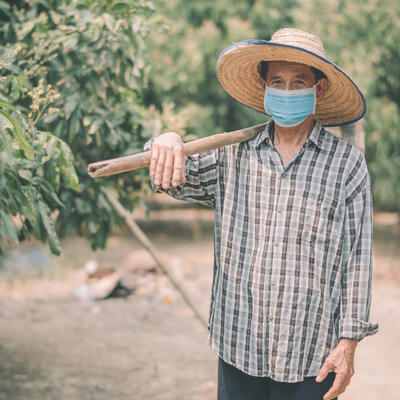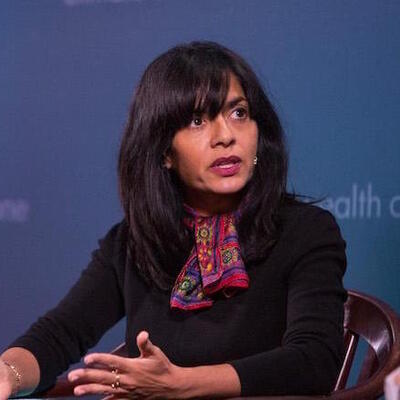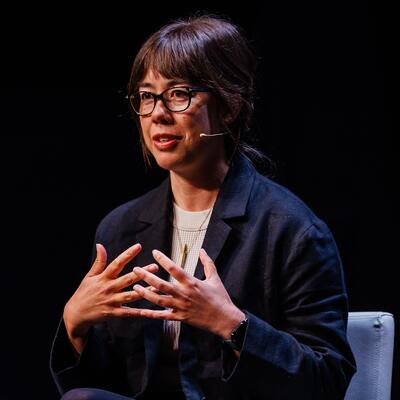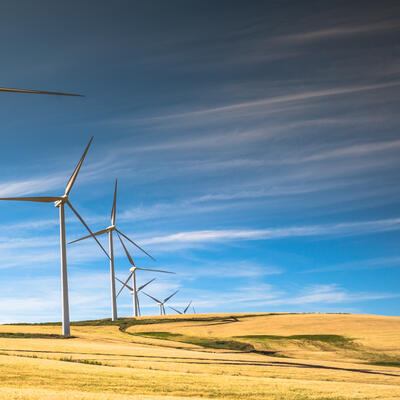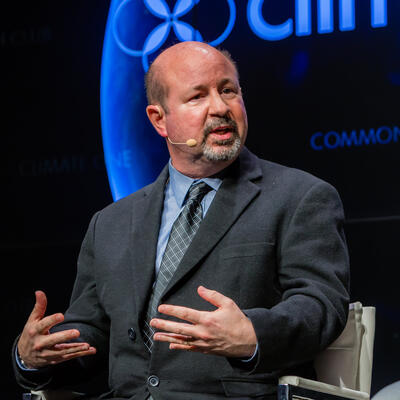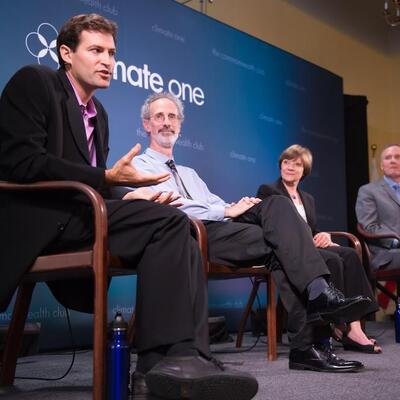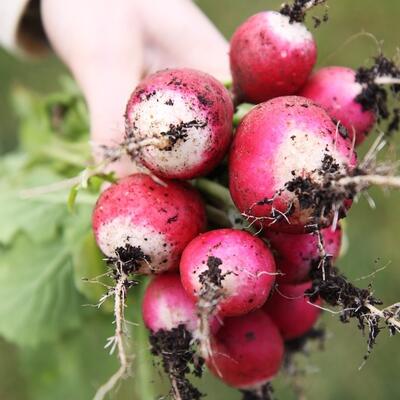
New Food Revolution
Guests
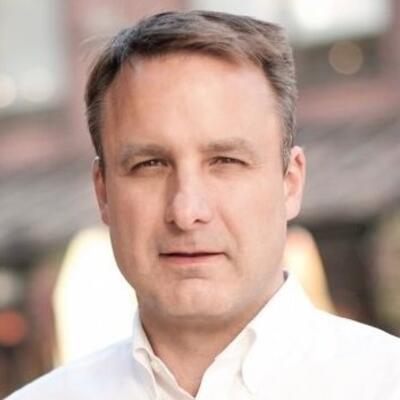
Jonathan Foley
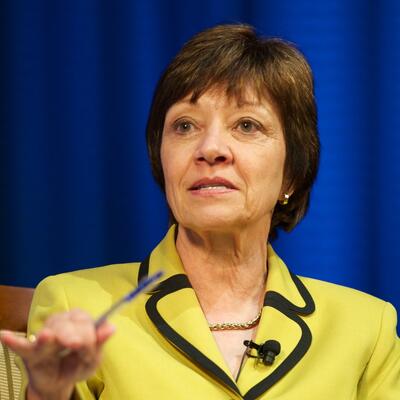
Karen Ross
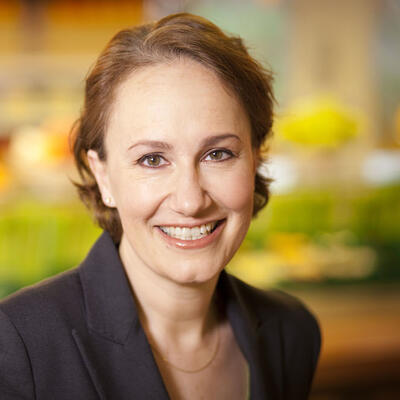
Helene York
Summary
The amount of food needed to feed the earth’s growing population is expected to double by mid-century. How will we manage the world’s food supply?
Karen Ross, California Secretary of Food and Agriculture; former Deputy US Secretary of Agriculture
Jonathan Foley, Executive Director, California Academy of Sciences
Helene York, Director, Google Global Accounts at Bon Appétit Management Company
Full Transcript
Greg Dalton: Welcome to Climate One, changing the conversation about America's energy, economy and environment. I’m Greg Dalton and today we’re talking about the future of food in a hot and crowded world. Global food production must double in coming decades to feed the 9 billion people forecast to live on earth by midcentury. How will that happen and what role will California play, what impact will climate disruption will have on food security in the United States and abroad.
Over the next hour we will talk about organic food, GMOs the local food movement and more with our live audience at the Commonwealth Club in San Francisco. We’re pleased to have with us three experts. Jonathan Foley is the Executive Director of the California Academy of Sciences and author of a recent cover story in the National Geographic on the new food revolution. Karen Ross is secretary of California Department of Food and Agriculture and former chief of staff at the US Department of Agriculture. And Helene York is director of Google global accounts at Bon Appétit Management Company. One of the tougher job titles that I had to pronounce recently. Please welcome them to Climate One.
[Applause]
Greg Dalton: Jonathan Foley, first of all welcome to San Francisco the Bay Area.
Jonathan Foley: Thank you.
Greg Dalton: Let's talk about the global food security, a hot world with 9 billion people. A lot of people would just say the answer is grow more, increase the supply, is that the solution?
Jonathan Foley: In a word no. Surprisingly we’ve had decades of success of growing more. It’s kind of the food equivalent of drill baby drill, you know, it’s sort of let’s just get more stuff. But we’re now exhausting the ability of our agricultural system to simply produce more and more and more.
We’re gonna have to be more thoughtful about the food we actually grow today and the nutrition and opportunity delivers for people around the world. You mentioned into your intro that people will say we need to double the amount of food by 2015. That’s true, if we do nothing about population growth, we do nothing about our diets and we do nothing about food waste. And I challenge that assumption I think we could do a lot about all three and work both on the supply of food but also how much we demand. And it turns out that's pretty much the only way we could balance the books for the future, just look at both.
Greg Dalton: Karen Ross, you oversee an industry that would like to increase supply, production profits that’s good for the agriculture community. We’ve had guests here before say, yeah we’re happy to meet that supply but is increased supply the answer?
Karen Ross: Actually I’m going to say yes in some way because I really believe that there’s much more we can do to optimize the resources that we’re using now to what we grow so that every acre itself can be more productive without tearing out more land, without using more water, without using more fertilizer. So I think it's really about optimizing the resources that we’re using to get the best we can, best crop per drop, best crop per acre. But I also think there is a huge interest and opportunity right now to better align nutrition. It’s not just about enough basic calories to survive, but the nutrition to thrive and really allow each individual to have access to that food and really achieve their potential. So I think it's really thinking differently about what we grow and how we grow it and maximizing what we have instead of the traditional way which has been let’s go tear out another 50 acres of pristine land and irrigate more and add more. I think there's much more we can do with what we already have in production.
Greg Dalton: And that’s one of the main tenants of Jonathan's plan for feeding the world is sort of work with the agricultural land already in production rather than cutting down the Amazon, et cetera. Helene York, you’re in the business of -- your company is in the business of supplying big institutions, feeding lots of people on a daily basis. Let’s have your take on whether increasing supply is the answer, and your position on sourcing all that for your company.
Helene York: Well, what we do is feed people at work and we feed people in universities. We are currently feeding 150,000 meals a week. It’s a lot of food. But we get that food from small producers for medium-sized producers and from larger producers. And what I'm seeing is a lot of smart agriculture and there are all different sized farmers and producers of food, ranchers, fishermen, aquaculture that are doing things very, very responsibly and thinking about the limited resources that they have, thinking about the future and saying I’m not going to have all of this land all of this pristine water that I've had in the past, I need to do things smarter than I've done it in the past. So I think that there are many producers that actually do need to get smarter about what they're doing and there are also others who really gotten to a maximum sustainable yield that both works for the farmers and works for pricing so that there's access for everybody, for that food but that we’re really producing a lot of nutritious food.
Greg Dalton: This is Climate One so we want to talk about climate change. What are the climate impacts on the food system today, Jonathan Foley? Looking globally, many people think about climate change as a future problem - it’s here now and today. And how is it affecting the food system globally?
Jonathan Foley: Well, there’s two answers to that question. One is how climate changes we’re already seeing. This is not science fiction set in the distant future, it’s right here right now. Maybe in California, depends on how you think about that. But we’re seeing an increasing frequency of things like droughts increase in severe rainstorms in a lot of the world especially our bread baskets, and overall increasing temperatures which make the soil evaporate more water.
So generally we’re seeing a much more frequent water stress just at the time we don’t need that. Just as we’re exploding water uses population and demand for water generally is going up, the reliability of that water is going down. So that's a really, you know, really big conflict. That’s happening all over the world. But there’s also the problem of how agriculture contributes to climate change which may be the opportunity side of this in some ways. A lot of people don’t realize agriculture in a way is the biggest contributor to climate change of any economic sector. We usually think of it as an energy problem and that’s kind of true; about 60% of our greenhouse gas emissions come from energy. But when you break it down by economic sector, it turns out agriculture releases about 30%, mostly from deforestation, methane coming from cattle and rice fields, and something called nitrous oxide. When we over fertilize fields with too much fertilizer, they release the stuff called nitrous oxide. That’s bigger than any of the energy sectors; it’s about twice as big as all the world’s transportation. So on one side climate change is crucial to the future of agriculture but agriculture is also critical to the future of addressing our climate problems.
Greg Dalton: Karen Ross, a lot of people think about climate change they think about tailpipes and smokestack, they don't think about their dinner plate. Do you agree that food’s a big part of the climate problem and also the solution?
Karen Ross: Well, of course I tend to look at how we’re impacted and here in California, we are already impacted. It’s not just about the water but I think for us in the state our most efficient water storage is snowpack in the Sierras and we know that that is exactly what our problem is right now, were not having that there to melt throughout the season to feed into the places that we can then move it around, and we see that it’s very real in our future so that is a very real issue. We know that it's not just the high temperatures. It’s nighttime temperatures as an example that have a huge impact on things like premium wine grapes and our fruit crops in the state. It's also the lack of winter chill hours, which then moves us out of certain markets. And will cause us to have to look at other potential locations to grow a lot of the fruits and nuts and vegetables that we have here. And it’s also more wheats, which also causes a water problem, and really destroys ecosystems. And these invasive pests; we’re seeing pests that we’ve never seen here before, part of that is just because we have global trade and people moving around the globe. But we are also seeing that in our forests as well in our ag lands, pests occurring in places and zones that they never did before. All of those are huge impacts. On the other hand, I do want to say, your percentage on that ag contribution to climate change is on a global basis; in California it’s about 8%.
Greg Dalton: Yup.
Karen Ross: So I just want to assure that on globally, we have huge issues. But that’s exactly where, if we were to think about our farms and how we farm in more holistic way and how we want to address certain issues and take it out of the silos and take a more integrated resource management approach, holistic approach, and think about and what we’re trying to do here in the state with Governor Brown's leadership on climate change, both mitigation and adaptation. When we improve our irrigation practices, we’re using less water; we’re using less energy or reducing greenhouse gas emissions. When we take that kind of holistic approach and really help our farmers have access to those tools and those technologies, we can mitigate and also adapt along the way. We need to have more public funding of agricultural research to improve our varietals, so that we can adapt to those temperatures, and that’s been identified. We do need to do more to invest in soil health. It’s like let’s go back to the future in the good old days of how do we build our resiliency in our soil health. There's a lot of things that we can do that can help the smallest growers anywhere in the planet but also are important for what we do here.
Greg Dalton: We will get to soil health in a minute. But let’s pick up on water because it is a big driver, it’s one reason milk prices are very high right now, historic high prices perhaps that’s been because of drought related. There’s some other, yeah, let’s talk about the drought impacts and where that goes for California, Karen Ross. It’s affecting the nuts, almond production et cetera. It’s really hitting workers so it’s here now this drought.
Karen Ross: Yeah. When we look at this year, 2014, the impacts have been minimalized by some but they’re not really thinking about those human impacts in rural communities that are extremely dependent upon agriculture is almost the sole economic driver in that community. So when you look at a $2.2 billion impact to California agriculture out of our trillions and trillions of state economy. It seems small and it’s easy to trivialize.
Greg Dalton: Are you saying that’s the drought impact?
Karen Ross: That’s what we’re calculating estimating it for this year, 17,100 jobs. So those are what we’re looking at for this year but this year because our farmers plan ahead. There were some carryover water and surface water deliveries that they were able to do some transfers and groundwater was serving the purpose that groundwater was intended to do. Get us through droughts. But we cannot use groundwater every year the way we do in drought years or we won't have that as a sustainable buffer for future droughts. So next year going into 2015 we don't have that carryover. There's going to be less options for how we manage drought and we can anticipate even harsher consequences if we have another dry year this year.
Greg Dalton: Helene York, you go and visit farmers what evidence are you seeing of the drought and how it’s affecting farmers and farm workers?
Helene York: Absolutely, first of all I hear from our suppliers every single week. We can't deliver certain a product to you, or the prices are going to be higher because of the things that Secretary Ross was just talking about. About the temperatures during the day. This year has been the latest delivery of products meaning those that have been harvested much later in the season and this has started months and months ago.
So the effect that I find when I talked to farmers is they talk about that they’re talking about the concern that the groundwater level is so low that there's more nitrates. And they’re very scared about that because they don't want to run afoul of California regulations and they don't want to do what's irresponsible. And so they are planting less and less acreage. Most of the food that we buy certainly the produce comes from California, over 80% of it. And more and more the producers are saying we have to move out of state we are moving to Mexico, we are moving to other Western states, and it's scary. At the same time we do get some of our produce from the northwest and our grains a lot from the Northwest where there’s a lot of rainfall. There's been too much rainfall and so that has also affected supplies in a way that we hadn’t -- yeah, I mean it's scary because it is affecting availability, supplies, pricing, and it's really making more expensive the kinds of foods that we want people to eat. It's the plant centric foods that are -- you know, delicious vegetables and grapefruit and lot of growers are having a very hard time delivering what they have delivered in the past.
Greg Dalton: Jonathan Foley, some people might hear that and say that farmers are profligate wasteful with water. That they don't pay reasonable price for the water that they use and that this is kind of, I don’t know payback comeuppance for them. And that this, you know, that they’re wasteful, your comment on that?
Jonathan Foley: Well thanks for the loaded question. [Laugher and crosstalk]
Well, I wouldn’t say anybody is wasteful. I think people are doing exactly what they were told. We’ve set up policies over the years that we’re incentivizing certain kinds of behaviors and there’s no raw market price for water. We’re going to have to think differently in the future about water and asking what do we get for every drop, how much nutrition can we deliver to the American household or somewhere around the world for every drop of water.
The good news is that while we’ve been maybe inefficient in some places around the world, there are huge opportunities to be more efficient. The Israelis for example really lead the world on turning a drop of water into more calories than anybody. The typical Israeli farm is about ten times more efficient than the typical American farm in turning water into food. We’re ten times more efficient on the typical farm in India and Pakistan. So it’s a hundredfold difference in the efficiency of irrigation and that’s at the national level. If you drill down to individual farmers there might be a thousand fold difference between some of the best farmers in the world, many of whom are here in California, and the least efficient. So that's the role of technology, that’s the role of innovation, that’s the role of maybe some better market signals, so that water isn’t a free good, it’s something of public good and has to be accounted for accordingly.
And we have to think very differently about water in California. We have water competing for food, for nature, for energy, for municipalities and we’ll have to choose. How do we prioritize those things? But fortunately the envelope for innovation to push how we can get all of those things out of our water system is enormous and we’re in the most innovative place in the world. Hopefully we can solve it.
Karen Ross: Yes, and --
Greg Dalton: Karen Ross.
Karen Ross: Can I point out, thank you Californians we passed with a high margin a water bond for investment. And that water bond was constructed around the California water action plan that the governor charged us to release earlier this year. And it’s not one thing, it's all things, and first and foremost that we as Californians must develop a culture of conservation. Each one of us have so much that we could do in that regard, including on the farms.
Recycle things, storm water capture, restoration, thinking about the whole watershed and what we can do and have water that will help us throughout all of this. So we have this chance for investment and we have this opportunity because people are being attracted to agriculture, because they know it's necessary, that it’s under pressure, and so there is this opportunity for technology to be applied in ways. We’ve made huge strides but we have so much more we can do about 50% of the California irrigated acreage is under some form of precision irrigation technology now. That means there’s 50% more to go. And the technology itself is already being used every year there's new precision being brought to it and there’s new data that can be used. So I think that opportunities, doing all of the above, not just one thing, is going to help us as Californians make sure that our economy, our environment and our people have the water that we need to continue to grow.
Greg Dalton: Karen Ross is secretary of the California Department of Food and Agriculture. You’re listening to Climate One. Today, we’re talking about food in California around the world, other guests are Helene York for Bon Appétit Management Company and Jonathan Foley, Executive Director of the California Academy of Sciences. I’m Greg Dalton. A lot of people talk about a sustainable food system. What does that look like? Jonathan Foley, if you paint a picture, what does a sustainable food system mean? What’s it look like in the grocery store, on the dinner table?
Jonathan Foley: You’re giving me all the good questions, alright. Well that will be very dependent on who you’re asking and how you define sustainability of course, so I’ll just give you mine. Agriculture is such a basic human enterprise. It’s about feeding our world, about creating opportunity for farmers and everyone through the supply chain all the way to the restaurant or who serves the food and of course about the environment. So I think we have to think about those three dimensions: nutrition, about the economics of agriculture and certainly about the environment.
And a sustainable agricultural system would be the one that looks at all three dimensions simultaneously. But how do we provide the most nutrition, the most opportunities for the agricultural economy especially in jobs in rural communities and this is the part that I’m so very concerned about is the environmental dimensions. We’ve made tremendous successes in maybe the other two in the last 50 years, but we’ve paid a lot of environmental prices for that around the world. And I think in the last decade or two much of the world has woken up to that, saying oh, well we can’t keep doing what we’re doing.
I mean just think about this right now. Agriculture right now uses about 40% of all of the land on the entire planet, that’s incredible. All the world’s cities put together is less 1% of the earth’s land surface, ag is 40. And it’s getting bigger every day, invading rainforests and other things. In water, agriculture uses 70 or 90% depending on how you do that math of all of the water consumed on the planet it’s by far the biggest thing we do. And as I mentioned earlier in the hour agriculture by economic sector is the biggest contributor to climate change. So if you want a sustainable world for a climate that isn’t out of control, not overusing our water and not expanding into our rainforest, you’ve got to figure out ag. And we have to do that while feeding a growing world with a changing climate while still supporting an agriculture economy. This is maybe the greatest the grand challenge we’re going to face in the century, is revolutionizing our food system. But fortunately, we have more tools than we’ve ever had to do it.
Greg Dalton: Helene York, how is Google approaching food and part of the solution to kind of building the kind of food system that Jonathan Foley just outlined, or at least moving in that direction?
Helene York: Well I thought that was a darn good definition. I actually teach a course for chefs at Google. Looking at what is a sustainable food system.
Because I think we have in our minds this idea that it's only about small and local and organic. And the chefs have certainly had that education through public media and we talk about, we start with the values of three different groups. What if you are single parents, I divide them into three groups: single parents, farmer fourth-generation Central Valley farmer that grows crops that we love and use every day and also environmentalists really concerned about climate change. And I asked them to come up with the values that would define sustainable food system for them. And then we look at the list that I just gave you and we see that we can come up with about 20 different attributes that it isn't where sustainable, local, organic -- words that are not the same but are often linked as if they were one, is one subset, but we have many other values here. And as a society I think our highest value is really providing good nutrition for everybody. And that's something that we often don't do enough of. And the way you achieve that and the way we try to achieve that at Google is to really set a balance. We’re not trying to find the apex of anything. It's not the most organic or the most delicious -- although we’re very into delicious because you really can't convince people that eat really good food unless you start with deliciousness. And that is really at the core of Bon Appétit’s philosophy, you start with good food. More and more we’re introducing plant-centric food. And we start our lines in a café line with three different wonderful vegetables. And by the time you’ve filled your purposefully smaller plate, you are mostly fall on that plate and you say, wow I have a delicious three colored meal here.
I'll take a little bit meat or fish on the top. It'll be our garnish and I think that's really the food philosophy: you provide great tasting food, plant centric and everything else is kind of a garnish, we don't need 16 ounces of protein a day. Humans do not need that. But if you look at what we eat in the United States it often approaches that number. But if we dial that back, because there’s so much more energy needed to produce proteins, if we eat what we need, then we leave a lot of resources to provide and grow vegetables that are delicious.
Greg Dalton: Helene York, I just want to follow up one thing and then go to Karen Ross. You talk about how Google balances things, you believe that there’s actually some tension between animal welfare and environmental efficiency, that free range chicken requires more time, more feed, more land, more fertilizer, that there’s some sort of tension between the environment and humane treatment of animals, is that right?
Helene York: You know this is hard for me to talk about because I used to be on the board of Certified Humane. But I am a committed environmentalist. So I've seen the conflict in the purchasing that we do. And I visited farms that do things very well from an animal welfare standpoint and others that do things from a very efficient, environmentally efficient standpoint. And I think that there is a point where you can really respect animal welfare, but don't go to the highest degree of animal welfare. I mean we are raising them for food. So I think there's an inherent contradiction right there. But there are -- if you are respecting the animal at a minimal important level, you’re also then respecting the workers all involved in that process, which I think is also very important, and that you are producing healthy proteins, especially if you're talking about the little animals that take less energy and less time to grow.
But if you have a chicken, for example, which is a pretty darn efficient protein from an environmental standpoint. And they typically grow now to 42 days. If they're around for 47 days to get to that same market weight they’re eating five more days of food. Five more days means that different products were grown on the land with more fertilizer, more pesticides, more water, heavier transportation to get -- because most food does not get produced where the animals are raised. That has a real environmental consequence. And so I think as a society we have to not choose environmental efficiency always to the nth degree or economic efficiency or animal welfare. I think we have to look at all of these values and balance them and find the sweet spots.
Greg Dalton: It sound like a -- I mean some people might view that as a defense of big ag.
Helene York: Yeah, I think that big ag is getting better at balancing these considerations, not every company, but there are real differences among the different companies. I have been to more slaughterhouses than I care to mention which is odd because I don't even eat meat, but I have been to many animal production facilities around the country. I’ve seen animals grown. And I think that there are that the industry is really evolving it’s always changing. It's not fair to say that all the little guys are good and all the big guys are bad. It's just not fair. It doesn't bear out with repeated visits. We can learn from the small guys we can learn from the big guys and I think that's true not only in animal agriculture, but I think it’s true in crop agriculture as well.
Greg Dalton: Karen Ross, let’s have your response. And thinking about big guys, a lot of people think about factory farms.
Karen Ross: They do and I think what’s overlooked again is that human consequence, because our agricultural system has been so productive and efficient that we’ve become more disconnected from understanding that all of those big guys started as small farms. Many of them were four or five generations ago, and especially many of my friends in the Central Valley are in the fourth or fifth generation and when they're lucky and successful they've grown and they are attracted to the next generation wanting to come to that family. So all the sudden, instead of supporting one mom and dad and the two kids, you’re supporting mom and dad, their children who are now married and have children and all of a sudden you got cousins if you're successful. So you grow either by size or you grow by vertical integration and the ones that I'm most familiar with have made huge contributions to the advancement of improved practices because they’ve got those family values of wanting to make sure. We've had five generations, we’ve got three that are active in it today, and we see the next two coming into this business. And it drives a lot of their family company values to really take that stewardship very, very responsibly and they stay connected to their customers. At the end of the day, I'm a government regulator but we all respond much faster to markets. Government’s usually lacking and what Helene describes and what she's doing for her company drives change much faster than a set of regulations in Sacramento or Washington DC.
Greg Dalton: Jonathan Foley, let’s get you on that, the factory farms. A lot of huge corporations call themselves family run because they are maybe run by a founder; they can be large corporations and still be family led. And your take on the factory farms and whether we’ve hit peak beef.
Karen Ross: You’re really giving us --
Jonathan Foley: Yeah, giving me the great questions, oh my God. Well, I think like others have said just before, I mean there is no one-size-fits-all solution to this problem, that’s not a good plan. Whoever you are in the food spectrum, whether you like big ag or small ag, I mean the other side is not going away, right? That’s not a good plan. So a good plan says we want all agriculture to get better. So I think it’s not really very pragmatic to say it only should be small and local or should only be big and global. It’s like look, we’re going to have all of this, we’re going to have to move all of the needles forward and get them all better, would be sort of my take on that. But what worries me isn’t so much the size of farms. I think the elephant in the room in a lot of these conversations isn’t the size of the actual parcel of land, it’s really the disproportionate power in the political process that some commodity agricultural systems have. Why do we grow 100 million acres of corn in this country? That’s bigger than the size of California by the way. Why do we do that? It doesn’t have all that much to do with nutrition or the environment I can tell you that. So I think there is a question there. So big ag doesn’t necessarily mean big parcels of land, it might mean big power blocs that have locked in certain kinds of modes of behavior, that maybe good, might be bad, I’m trying to be neutral here. But it’s the question that’s so different than big farms, there is big ag, means a different thing. And I’m not judging that but it’s something we have to recognize, why that’s a concern.
Greg Dalton: Karen Ross, you work at the US Department of Agriculture where there’s -- king corn has a pretty strong hold. Do you see anything changing toward the corn lobby? It’s both Republicans and Democrats have pretty well saddled up to that trough of corn and were pretty deeply into it. Is that something that needs to change in a hot and crowded world?
Karen Ross: Well, I think this last farm bill is one step in that change with the elimination of some of the subsidy programs and moving it more to managing risk. And farmers taking on more of that responsibility than they have in the past. And I think Secretary Vilsack is providing outstanding leadership. This is a man who cares passionately about rural communities and that we don't have people continuing to leave rural communities and abandon them. So he's looking at how does the ag system, how does a plant-based society, create jobs and value added and what are the all the products that we can do many of them have been byproducts and treated as waste in the past. How do we convert that to useful products, we’ve got a whole bio preferred based on the content that's from plant-based, what normally would have been waste. So I think there's an opportunity to open up the discussion about all the things that farms can produce that we as consumers use in our daily lives. Because if there's not a market for it -- well the farm bill in the past, it didn’t matter if there’s a market on some of those things. So let me correct myself.
Greg Dalton: The government will pay anyways, yeah, right.
Karen Ross: But that has definitely gone away. So I think that when we look at that, a lot of that was driven because we wanted to get off of our dependence, our over dependence on foreign oil as an example. So there were other motivations, not just the farm and ag motivations that created some of the structures that we’re living with. And the corn producers invested in 25, 30 years ago alternative uses, so now the first plastic forks you know, everyone was so proud, that all of a sudden we have plant based plastic forks and plastic bags and other ways of using those products. So it's become very complex and now we have these economies that are starting to grow in the Midwest, where you moved from, and all of a sudden those communities have jobs that they didn’t used to have. So we’re not making our decisions going forward, any easier around the corn challenge. How is that for not answering your question?
Greg Dalton: Pretty good. Karen Ross is secretary of Food and Agriculture in California. Let’s talk about GMOs can we feed a hot and crowded world with -- are GMOs necessary Karen Ross to feed the nine billion people who’ll be with us shortly?
Karen Ross: Well, as an English major who has a complete and total appreciation for science and what science can do for us, I'm not willing to take any tools off the table. And I think that the science of better understanding genetics and what are the good ones and the bad ones and how we use that for plant breeding, is a very important element of continuing to improve our adaptability for climate change or anything else that comes our way. What I think we have is if we, as consumers don't understand that science and what its impact is, and it’s obscure to us and it feels like someone is trying to hide something from us, then we have legitimate reasons for questioning it.
I personally believe that we should figure out the labeling issue. People want transparency. What I don't like to see is if we try to piecemeal the labeling, which makes your life very complicated and anyone who’s in the food chain’s life complicated -- let's address us as adults using good information and figure it out at the national level and say this is the way we’re going to go.
Consumers want to know, and that the fear of being engaged in that conversation feels like a deceit that's going on, and I think that we just have to be very open and honest and have that discussion and figure out how to have disclosure. And if it’s so scary that we can’t explain it and welcome our consumers into that conversation, then there's something there.
I personally don't think it is but many people do and until we can have a better discussion than one around 30-second sound bites at a ballot box, we’re not going to be able to advance that discussion at all and we just need to have an informed discussion.
Greg Dalton: Jonathan Foley, labeling laws went down at the ballot box in the November elections in Oregon and Colorado. Your take on GMOs, on their promise and their role going forward.
Jonathan Foley: Well, I think it’s like Secretary Ross is saying there’s a technology that has some promise at a purely technological level. But what worries me about GMOs is just the incredible level of hubris in which they’ve been used. It isn’t the technology per se, but what troubles me is that -- and what really bugs me is when people say, oh but the science is fine. Like no, actually there’s a whole lot of other sciences that wasn’t fine. Like ecology, saying that like you can’t put out a weed resistant crop and expect the weeds to sit still, they will evolve. They’ll come around and now we have weed versus -- you know, we have Roundup resistant weeds, we have BT resistant bugs. Everybody knew that was going to happen, every ecologist predicted that. But GMO advocates said no, no, no, that won’t happen, we’ll work around it. Well, here it is. So it’s really a big problem.
And so I think it is a little bit of hubris there and also the labeling issue, like ignoring public sentiment and trust issues. So I worry about that a lot. And sometimes GMO’s have been over vilified to be sure, but they’re certainly been overhyped. The traits that we’ve introduced have really been about kind of pests and weed resistance. We’ve never really improved the yields. Not very much, European corn and soybeans have the same yield as American corn and soybeans, we use GMOs, they don’t. There’s not that different. We’ve seen some yield improvements in cotton, yes, maybe canola, papaya, a few crops where in major crops, not much yield improvement. And they’re the crops we don’t need so much of; they’re the ones that aren’t actually food. So this argument that GMOs are needed to feed a growing world just doesn’t hold water for me.
Doesn’t mean I don’t think GMOs play a role but I think they’ve been really overhyped by some and over vilified maybe by some others. And that’s not a good conversation to have, we need a -- I think like Secretary Ross said, much more of a calm where do we use these and when. I’d have to say I’d really like to keep that option on the table, but more on the “in emergency break glass” mode. If we had a widespread disease, like oh my God there’s some new wheat fungus that’s coming out. Wheat rust that’s damaging one of the most important crops in the world and the only way we could possibly solve this is with the GMO. Or like citrus greening, we’re starting to see the problem.
Karen Ross: Yeah, I was just going to bring that one.
Jonathan Foley: Yeah, like wiping out citrus crops in America, if that’s the only way to go, maybe we need it. But there’s so many other promising technologies like marker assisted breeding using the tool set. Genetic engineering developed to see what the genes do, learn how to play the piano of the genes if you will. But use natural breeding techniques aided by that technology but is basically still resorting to traditional breeding but now with the roadmap of gene sequencing can give you but it’s not splicing their gene, it’s just knowing what they do. That’s probably more promising.
Greg Dalton: Jonathan Foley is the executive director of the California Academy of Sciences. You’re listening to Climate One, I’m Greg Dalton. Helene York, do you feed genetically engineered food to the engineers at Google?
Helene York: GMOs are part of the American food system. Not as much as most people think, but there is a tiny element of GMOs in 80 to 90% of the cheese that is eaten. I mean it’s part of the rennet and it's a very interesting one of those trade-off things. Why do we have GMO rennet? It's because 40 years ago, people were very concerned with the way veal calves were raised and so veal became something people didn't eat. And rennet, which coagulates the milk to become cheese, and give it its form, it's very important even though it's less than 1% of the total -- major companies that were actually cheese producers said oh my gosh, what are we going to do, the price of rennet is just from calves linings of their stomachs is going through the roof and it's not going to become available. So they created alternatives and now literally 80 to 90% of the cheese that we eat has rennet that is developed from a GMO process. It's a tiny, tiny fraction. And the concern that I have about labeling, and I will tell you that I'm sympathetic to people want to know what they're eating; I think that’s a great thing. But how do you label something that's less than 1%? And how do you label all of the different things if we took other values. A little bit of this little bit of that. And if you look at packaged foods these days, almost anything, you could have a list of 100 different things and how do you do that? Soy lecithin is something that you see also teeny-weeny little emulsifier as a total package. Is it more important to label that as GMO? If it's less than 1% maybe there's a threshold, there than it is to say, this has an enormous amount of saturated fat or this comes from a particular place or whatever the other value is. Good is about values.
So we do serve cheese, we have some canola oil in some of our kitchen processes and our chefs use canola, but they also use other oils. In fact, we have a policy in place that no café can only use canola oil during the day because we know that some people really want to avoid GMOs or highly processed, that's the buzz word, the highly processed oils.
And you know what, we want to respect that. So we allow our chefs, we even required them to use more than one kind of oil. And most cafés use three, so the Google food program really is about choice and about nourishment to be able to perform well. To have some food where it's within walking distance, you can sit with your colleagues and you can explode ideas off each other. There's a theory in Google that Gmail, which many of us use, was actually created over lunch at a Google cafeteria. And so we’re very proud of the great food that we provide. A little bit of it, a tiny fraction is GMO and but it's a very tiny fraction. We cannot, though -- I want to talk that labeling just for a moment. If we were required to label because the community said we really want to know, and there was no Federal requirement as Secretary Ross was talking about, there's no way we could get that information. Because if manufacturers are not required to tell us we do not have the capability of knowing if the tiny fraction of items other than canola oil or feed corn that goes into masa tortilla chips, we could not know. So it put us in a funny position because if we were required to do that, we’d want to do that, honestly and very sincerely, and we would not have the information.
Greg Dalton: Helene York is director of Google Global Accounts at Bon Appétit Management Company; you’re listening to Climate One. I’m Greg Dalton. Food waste is a big part of the issue. Jonathan Foley, that’s one pillar of your plan that you outlay in a beautiful article in National Geographic. Let’s talk about food waste and how that can be reduced to increase, address the food security situation.
Jonathan Foley: Yeah, so we’ve about two dimensions of the demand for food that could be changed, diets, biofuels, but the big one is like food waste. And we’re talking actually before the show that maybe we shouldn’t even call it waste. It’s sort of not yet used food. A lot of it is perfectly good --
Greg Dalton: And I think Helene York probably recycled some of it at the Google cafeteria.
Jonathan Foley: Yeah. And nobody wants to be told they’re being fed waste so yeah --
Helene York: We’re recycling.
Greg Dalton: Leftovers.
Karen Ross: The leftovers.
Helene York: Yes, yes.
Jonathan Foley: Smart food we should call it or something, I don’t know. But the numbers were astonishing. It’s about 40% of all the food grown in the world isn’t then consumed. And that’s not just in the United States, that’s all over the world. Rich countries it tend to be lost in the food system, that opportunity to feed people is lost usually around the consumer near us in a restaurant, maybe in a cafeteria, maybe in our refrigerators and our Tupperware with lots of good intentions but it just doesn’t get in our tummies. But where we have food loss in a lot of developing countries is near the farmer. They grew the food but maybe it couldn’t get harvested in time, maybe the insects got to it or maybe it rotted in storage because the trains weren’t on time or the truck didn’t get where it’s supposed to go. So it’s more of an infrastructure problem not an overconsumption problem.
And what a great opportunity, you know, if we’re 40% not delivering of what we produced then mine that, find ways to use that. And there are a lot of promising places where that could happen. Obviously Helene can speak much more to this but changing the portion sizes in big operations that feed lots of people, getting rid of cafeteria trays turns out to be really important. Hong Kong for example is now out of landfill space, so most of the major food deliverers there are getting very smart about just the right portions, about creating a culture of reducing waste.
But also “food waste” is also often tied to our food safety concerns. The labels we have on our milk jugs, on our yogurt, “best used by” or whatever. What does that mean, I wonder? How can yogurt go bad really, I mean what does that even mean? And, you know, we tend to throw it out as being risk adverse people, nobody wants to get sick and have food poisoning. But yet maybe we’re throwing away gold mine that we don’t need to. I’d love to see our venture capital here in California develop smart labels, that oh, a little red dot will appear on the milk jug when the bacteria account gets high. That’s where we should be using biotech, or on our meat. So it’s improving food safety, better logistics of food supply chain delivery and reducing that lost opportunity of feeding everyone everything we grow.
Greg Dalton: And Karen Ross on that, and also composting could be perhaps a constructive use of the food that is wasted so it becomes fuel for future food.
Karen Ross: Yeah, thank you for that. There are two things I wanted to touch on. One is that our state board of food and agriculture as a result of ag vision, which is a view of agriculture in the state by the year 2020, decided they wanted to turn excess, which happens throughout the season at any time. into access because we still have one in six Californians who are food insecure. So we set a goal to double the farm contributions to food banks to 200 million pounds by the year 2015. This year right now we’re about 165 million pounds so we’re really focusing on reaching that goal of 200 million pounds of food from farms and there are many ways that’s happening. And the food banks are wonderful, wonderful partners for us. They have some dollars that they can devote to just helping the farmer pay for just getting it out of the field so they can be doing second harvest. and that's one way of preventing any of it from going to waste in out on the farm itself. Sometimes it’s just, there’s not a market there once it is harvested and so it’s already in the packing house making that contribution. It's a way for people to do something good for their community and know that it's not going to waste.
Farmers are so proud of what they produced they hate the thought that it might not going to people's tummies. So that’s something we’re very interested in doing. We also as a result of the governor's leadership on really addressing all things about climate change. How do we get more organic stuff meaning green stuff, food waste, out of landfills because of the methane issues? How do we get more that out of there and divert it into compost which then if you do the lifecycle analysis, landfills usually are far away from where we can get to the farms and it’s going to require trucks. But really trying to think about more efficient ways of capturing all of that and making it something that's useful and can take the place of other types of fertilizers and be a part of putting it into our soils and building our soil health and building a resiliency. So I’ll think you’ll see a lot of activity around the composting piece of that and diversion from landfills over the next four years.
Greg Dalton: Jonathan Foley.
Jonathan Foley: Oh while we’re talking about the composting and food waste. So I just want to kind of make the point that our food system is the only ecosystem ever invented in nature to ever have waste. There’s nothing in nature called waste, it doesn’t exist. It’s just food for something else.
And so we have to think a lot more in our food system like ecological systems do, what’s not use one place is use somewhere else. Whether it’s repurpose food or repurpose organic matter for energy or for rebuilding the soil. We just got to be smarter than we’ve been. That’s certainly where we have room to grow there.
Greg Dalton: This is Climate One and we’re talking about food and climate change. I’m Greg Dalton, my guests are Helene York from Bon Appétit Management Company, Karen Ross, secretary of the California Department of Food and Agriculture and Jonathan Foley, executive director of the California Academy of Sciences. Let’s go to our audience questions, welcome to Climate One.
Diana Donlon: Hi, I’m Diana Donlon, I’m the director of the Center for Food Safety’s Cool Foods Campaign. And Secretary Ross, I was delighted to hear you mention the need to invest in soil health. What I find surprising is how rarely soil is mentioned in the context of California’s epic drought. How do you suggest we break down the silos between healthy soil and water?
Greg Dalton: Secretary Ross.
Karen Ross: So that’s a great question. Soil health certainly has a role to play with increasing the resiliency and water holding capacity of our soils. And so I think just based on some initial discussions we started to have cross cabinet, we’re going to be putting a lot more into this. It's also interesting and relevant to note that USDA has revisited some of its roots from the depression and is doing a soil renaissance that's really taking across all those agencies at USDA of investing in soil health and really raising it and the awareness about it. And also very importantly, next year 2015 the UN has declared it the year of soil health because we’re coming to this understanding, we’ve been walking this earth for millions of years and there's really still so much we don't know about the ecosystem that we walk on every day. So I think there's a renewed interest of really taking a look at that and what we can invest in for the resiliency of this wonderful and very scarce resource.
Greg Dalton: Dirt deserves more respect let’s go to our next --
Karen Ross: Yes, dirt.
Greg Dalton: -- question, welcome.
Female Participant: Hi. I’m wondering about -- we didn't really talk about fossil fuels but we use, it’s a very fossil fuel heavy industry because all the fertilizers are made from natural gas. So if we’re going to go off those, how about going to recycling, not just food waste, but human waste and other types of waste? I know it’s a very radical idea, but I know Japan has had some success with that. And it's a potential for innovation, shall we say.
Greg Dalton: Jonathan Foley.
Jonathan Foley: Yeah -- [Laughter and crosstalk] I get the poo question.
Karen Ross: Somebody had to do it.
Jonathan Foley: Well, I think you’re absolutely right. There’s some really interesting points there. It’s not a new idea at all that actually for thousands of years and still to this day in much of China and India it was called night soil. So it’s a good old idea brought to a modern era. Human urine, not to be crass, is full of nitrogen and when we use excrete that, I’ll be polite, it goes into this clear water waste and it has to go to water treatment facility there are ways to capture that nitrogen which is actually quite sterile, it’s actually quite clean. How do we use that where it’s needed in agricultural production?
But also, yeah, we use a lot of energy to make fertilizers we’ve gotten better at that. It’s not that much compared to other parts of the economy but it still an important issue. There’s also some interesting ways you can make ammonia fertilizer from wind power actually, you don’t have to use natural gas. You just need to split water and make hydrogen and then combine that with water and then you can have the whole process of what’s called the Fischer-Tropsch reaction, just fancy chemistry. So there are other ways you see there are lots of renewable waste to get the nitrogen but the best ways do not have to use it all. And that’s where composting, agro ecology, organic methods are better recycling it on the farm so you don’t have to add as much in the first place.
Greg Dalton: Jonathan Foley is executive director of the California Academy of Sciences. This is Climate One. Let’s have our next question, welcome.
Cole Webber: Hi, I’m Cole Webber with the Packard Foundation and sort of building on what you’ve already talked about it as far as the overuse of fertilizers both in United States and the world. Some people do it very well and other people do it not so well. And how we’re being able to really help those people who are over fertilizing whether they are in this country or internationally to really use a much more sensible amount?
Greg Dalton: Secretary Ross.
Karen Ross: This is very front and center of some of our work for the last couple of years because of the issue of nitrates and groundwater, which is really forced us to look at the research that's been funded and how we make the results of that research user-friendly and in the hands of farmers to improve their practices and really focus on having the confidence in their system because it's kind of a risk management thing to over fertilize or the -- you know, it’s kind of the insurance policy. How do we build confidence in that? I would say and I know many of my friends would say this is where cooperative extension has made a huge difference and our cooperative extension model, those people who are the connectors in the university system to the bench researcher taking those results and getting them into the hands of users, which then stimulates innovation and improves the practices.
We've invested in creating curriculum for all those private consultants who are out there as certified crop advisors. They now have a curriculum and can be certified just this past year on improved nitrogen management practices to make sure that they're doing that and how to create a nitrogen balance sheet. It's all about getting that continuous stream of information to improve practices to the field sooner so that we can see the improvement in the application supervisors.
Greg Dalton: Jonathan Foley.
Jonathan Foley: Well just add to that too, taking it a little bit on a different perspective as well. It's really important to know that globally this nitrogen and phosphorus pollution too both of these things are in fertilizer that runoff or go into the atmosphere are very, very large. And right now it's astonishing. China would be first then India, then the United States are the three biggest polluters of fertilizer runoff. And those three countries alone are 70% of the world's. And of that, most of it, the vast majority, is in about three crops corn, rice and wheat. Countries that are getting it right would be Brazil and Australia; those are the two countries that get the most production for the least amount of fertilizer in the world. They hit a sweet spot of being very smart with fertilizer, better than we have but we’ve done better than other countries.
Greg Dalton: We’re talking about food and climate change at Climate One. Let’s have our next audience question, welcome.
Female Participant: Thank you for all being here number one. But I was wondering if you guys could talk on urban agriculture. There’s a lot of promotion at least locally for people to grow and sell their own but there's also big debate on the energy and water it takes to do such. So I was wondering if you could talk on that point.
Greg Dalton: Secretary Ross, people have you know, little small plots in cities or even some of these buildings with vertical farms.
Karen Ross: Right, they’re still on top. I’m a big supporter of that and I have a really self-centered reason for doing that. I think the closer we are to what it takes to produce food, the better informed consumers we’re going to be which then makes us better voters when it comes to things like land use policy and water, and all those other things. And I also think it is a wonderful way of teaching youth how to care for something, to really nurture something and follow it all the way through the system. Prepare it and really help inform their eating habits. So for all those kinds of reasons, I'm for it. But I also think that we can't afford in this fast-growing world population where people to want to feed their families better when they have more discretionary income, even a dollar more, then let's farm where the people are. Let's try to create sources where the people are. And it may feed the world population but it’s an important supplement to feeding the world population. And I think aquaculture in particular is a really important thing that we can do well in urban centers, and that there’s huge opportunities with that on hydroponics. So I'm a big supporter. I know that we have to do the lifecycle analysis on everything these days, but I think there's a lot of other co-benefits that come from that, beyond just the food itself that maybe we can't measure because of the societal benefits.
Greg Dalton: Lifecycle analysis being the --
Karen Ross: Yes.
Greg Dalton: -- pollution coming out of the trucks that takes food somewhere and all the fertilizer that goes into it. Helene York, urban agriculture?
Helene York: Yeah, I agree entirely with what you said but I also want to add another point which is that indoor agriculture I think is also a very important set of new technologies that we need to look --
Greg Dalton: You mean in Humboldt County, or no, not --
Helene York: Well, maybe there too.
Greg Dalton: Alright, okay, alright.
Helene York: The biggest ag producing county in the state, right? Now I mean, I've seen some indoor agriculture that's actually soil-based not water-based but very, very low energy, producing enormous amounts of green leafy vegetables with a lot less water and you don't have runoff and in warehouses, basically abandoned warehouses. So teaching people agricultural skills, providing very healthy food and also using a lot less energy than out in the fields.
Greg Dalton: We’ve got time for one last question. Let’s go to our next question, welcome.
Belinda Morris: Hi, I’m Belinda Morris with the Packard Foundation. I love the description that Helene had of the image of meat as garnish on a plateful of vegetables but in reality in developing and middle income countries, we have a growing middle class and as a result, we have a really increasing demand for meat. And as a direct effect of that an increasing demand for feed which is the corn the king corn and the soy that you are talking about. So I just wonder if you’ve done much thinking about how to address that issue going forward.
Jonathan Foley: Well you’re absolutely right. We’re living in a really interesting time right now where both populations and dietary affluence, what people want to eat, how rich on the food chain they want to be are changing very dramatically. But it turns out the increasing depth of our diets how rich our diets are getting is going faster than population by about a factor of two. So both of those are contributing increase in food demand but it’s really the increasing wealth particularly in China and also India right now that’s driving most of the world’s food system change. China alone right now, the cities of China are -- the single biggest accumulation of wealth in human history is happening right now and it’s reaching across the world. So I don’t know the answer to this, I wish I did. But one of the things we’ll have to figure out both where people already eat a lot of meat but where people will soon eat a lot of meat, how do we deflect the curve, how do we think about that proposition in new ways. If we can change the diets of the west and nudge the growing demand for meat in the east, we’d have a big way of solving a lot of this problem right there.
Greg Dalton: We have to end it there, our thanks to Helene York from Bon Appétit Management Company, Karen Ross, secretary of California Food and Agriculture and Jonathan Foley, executive director of California Academy of Sciences. I’m Greg Dalton. You can listen to a podcast of this and other Climate One programs in the iTunes store. Thanks for coming and thanks for listening here today.
[Applause]
[End]
